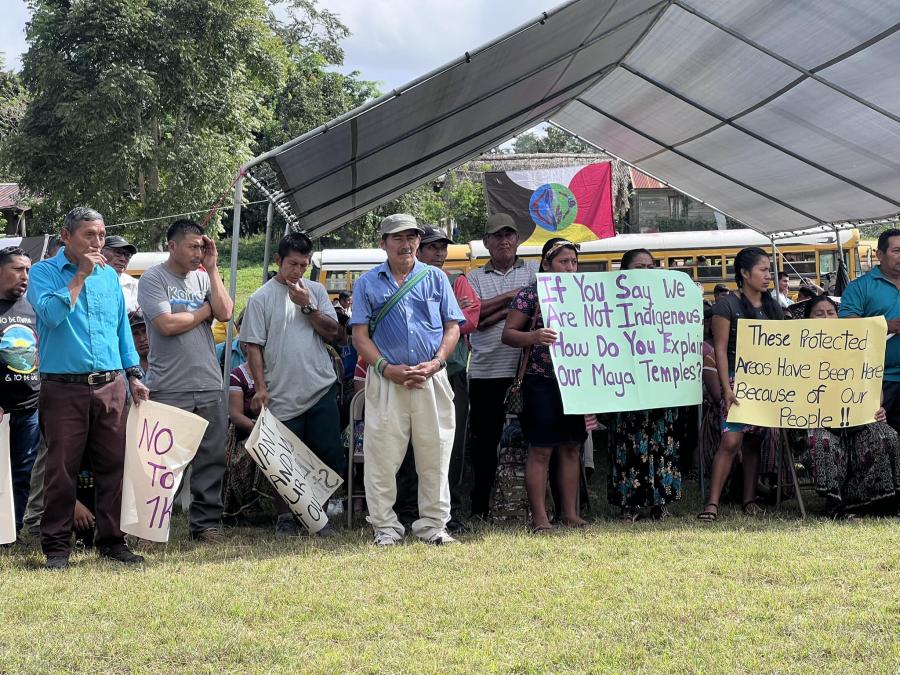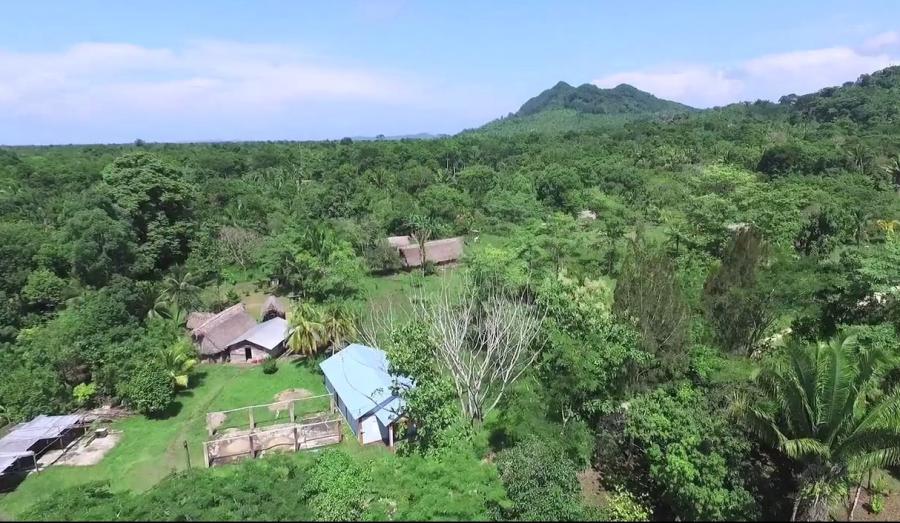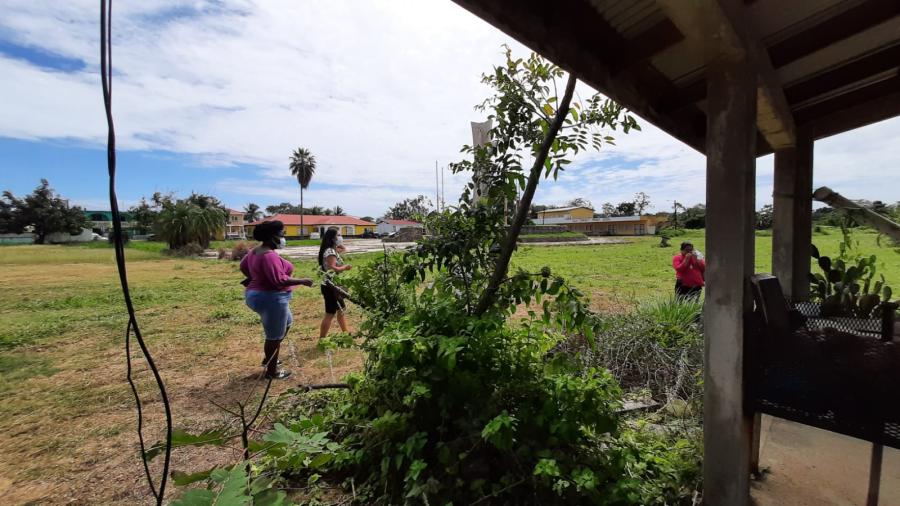Ethnocartography in the Darién.
The Caribbean coastal plain of Central America is a zone of dense tropical forests, natural pine savannahas, and mangrove estuaries. Stretching from Belize down through Panama, it contains the last remaining wilderness areas of the region, and as such contains a large portion of Central America's biodiversity. Until recently, this sparsely populated, remote region of high rainfall and difficult access had been isolated from the predations of the modern world.
All of this has changed over the last 40 years. With a steadily accelerating pace, new technologies are facilitating the construction of roads into the forests. As pressures on the overused and increasingly degraded arable lands of heavily populated interior provinces become greater, and the concentration of the best farm lands in the hands of terratenientes (large landholders) and land speculators continues, poor peasant farmers are forced to seek a living in the ecologically fragile outlying districts. Loggers and cattle ranchers follow this exodus, with the result that the forests are being cut down and burned off at a ferocious pace, to be replaced by cattle pasture and secondary growth stubble. The native peoples, who make up the majority of the population of this region, are being forced to make a last stand before being driven into cultural extinction.
At the present time, there are more than 20 distinct linguistic/ethnic groups living along Central America's Caribbean coast, where they are attempting to hold on to territories they have inhabited for thousands of years. As the colonists arrive in ever-increasing numbers, the Indians have begun to form organizations to fight for their land rights at the national level. Although they have received little outside technical or financial assistance, they are pulling themselves together and are gradually beginning to make a difference.
Examples of this movement are in evidence throughout the region. The Toledo Maya Cultural Council (TMCC) in southern Belize; federations of the Xicaque, Lenca, Chrotí, Garíuna, Pech, Miskito, and Tawahka in Honduras; Mikupia, a local group working to establish the Miskito Coast Protected Area in northeastern Nicaragua; the Asociación Nacional Indígena Salvadoreña (ANIS); and the Ngobe, Emberá, Wounaan, and Kuna General Congress in Panama - all are setting up systems adapted to the non-Indian contexts in which they must fight for control of their lands.
THE DARIÉN
The Darién region of Panama, with a total land area of 16,803 km* and approximately 45,000 people, is the most sparsely populated and least known area of the country. It contains the largest remaining chunk of intact forest and serves as a natural barrier separating Central from South America. In fact, since the 1970s it has been designated a buffer zone protecting North America from the spread of hoof-and-mouth disease from Colombia, where it has been endemic for decades. The only uncompleted stretch of the Pan-American Highway running from Alaska down to southern Argentina is found between the Panamanian town of Yaviza and the Colombian border, a distance of just over 100 kilometers.
Thirty years ago, all of eastern Panama - containing the Darién and part of the Panamá Provinces - was a region of largely intact tropical rain forest inhabited almost exclusively by three indigenous groups: the Emberá, the Wouaan, and the Kuna, as well as small colonies of darienitas, or African Americans descended from escaped slaves. Today, it has become a battleground on which the native inhabitants are struggling to stem the incursion of loggers, cattle ranchers, land specilators, and landless colonists from Panama's over-crowed interior provinces. Since the opening up of the region in the mid-1970s through the construction of the Bayano Hydroelectric Dam and the extension of the Pan-American Highway as far as Yaviza, the lush forests have been rapidly people. Now the region is faced with a new menace as plans are made a complete the final link in the Highway, joining the North and South American continents for the first time.
MAPPING FOR SURVIVAL
As a first step in coming to grips with this situation the General Congress of the Emberá, Wpunaan, and Kuna peoples, and the Centro de Estudios y Acción Social Panamenño (CEASPA) recently undertook a participatory land use mapping project of indigenous territory in the Darién. The methodology used in this project was adapted from a similar mapping initiative that the support organization MOPAWI (a Miskito acronym meaning region of Honduras in 1992. In contrast to the loose social organization of the Mosquitia, the indigenous groups of eastern Panama have a relatively sophisticated tribal political structure, sot that from the very start they took strong control of the process.
From May through October 1993, a team composed of cartographers and 22 indigenous "surveyors" from communities in the region compiled maps that detail the hydrographic features as well as the land use patterns of the local populations. Each surveyor had responsibility for a zone encompassing between three and six communities, which amounted to a manageable range for a single person to cover. In this way, all of the territory inhabited and exploited by the indigenous peoples of the Darién was covered.
The mapping was carried out through a series of three workshops. The first was held in the Emberá community of Arimae, where Andrew Leake (the co-coordinator of the mapping project in the Mosquitia), Nicanor González (a Kuna with Native Lands), and three indigenous coordinators - Genaro Pacheco and Facundo Sanapí, both Emberás, and Geraldes Hernández, a Kuna - met with the surveyors, who had been selected by the indigenous leaders of their respective groups. Together, they prepared two questionnaires in the community during the evenings so they would be adjusted to the realities of the region. In similar fashion, they role-played the explanations they would give to villagers about the mapping project. They also discussed strategies for drawing up mapsin the field.
After a week of preparation, the surveyors set off into the field, where they worked on census counts, questioned villagers extensively and filled out their land use questionnaires, and began putting together careful cartographic records of their zone with community members. They traveled by bus and by canoe, and made their way on foot along muddy trails through the forest; they withstood rain, insects, hungers and exhaustion. They carried with them a green plastic folder with a sheath of loose-leaf bond paper, pencils, pencil sharpeners, and ball-point pens. The most essential materials, were three 60 cm x 80cm sheets of blank manila paper, which were used to draw the maps. Official government base maps were not utilized, since the idea was to government base maps were not utilized, since the idea was to stimulate the surveyors and villagers to create their own maps with their own symbols. During fieldwork, the manila sheets with the drawings were protected in sections of plastic tubing with rubber stoppers.
In collaboration with villagers, especially the elders, the surveyors made meticulous drawings of the river systems and the areas where they hunt, fish, cut firewood., and gather materials for construction and medicines and fruit. In this fashion, the maps were built out of the accumulated geographical knowledge of the Indians, a type of "ethnocartography." It must be said that some surveyors produced better maps than others; but the best among them, crafted with copious detail and admirable talent, are works of art with great scientific value. It was clear to all involved that these maps would assist them to confront the future with more confidence.
With this information in hand, the surveyors returned to a second workshop, where they worked with Peter Herlihy (a University of Kansas geographer who was involved in the MOPAWI mapping project in Honduras and who had spent many years in the Darién) and several cartographers from the National Geographic Institute "Tommy Guardia" and the University of Panama. They worked together in intensive sessions to construct composite maps from government base maps. The surveyors utilized the information from the questionnaires and contributed everything they had learned, including the names of the rivers and other important landmarks in the indigenous language, for the construction of the final maps.
After three weeks, the surveyors journeyed to their zones to consult community members with the draft maps, fill in gaps, confirm boundary lines, and correct errors. They then came together again for a third workshop, where they put the final touches on the maps. At the end of the process, the team of Indians and cartographers, managed to produce a 1:250,000 master map of all the indigenous territory of the Darién, together with 22 1:50,000 zonal maps that detail the river systems and the land use patterns.
The government and university cartographers who participated estimate that the maps produced by this process are far more accurate and detailed than anything that has ever been done in the Darién. For years, the ever-present cloud cover had impeded aerial photography of the Darién, a circumstance that made official maps of the region no more than approximations, Confidence in the indigenous maps, however, is so high that the Instituto Geográfico plans to utilize the new information, including indigenous place names, in its up-coming revision of the official country map. But beyond an accurate depiction of the hydrographic features of the Darién, the maps give, for the first time, a clear indication of the extent of the territory utilized by the indigenous peoples and provides a basis for understanding the way they manage their natural resources.
The maps, of course, are a good deal more than academic exercise. Beyond their scientific worth, they have an important practical value as tools to protect indigenous lands and conserve the region's biodiversity. Before the project began, individual Indian villagers had little sense of how loggers, cattle ranchers, and landless peasant farmers were affecting the resources within the region as a whole. In this sense, working together on the maps provided a thorough education; it has raised their awareness of the numerous threats of their well-being and motivated them to seek collective strategies to curb the invasion of their lands. Conservationists, at the same time, can see from the maps that the areas of indigenous land use are also areas of relatively intact forest. The implication of this is that perhaps the best way to preserve what is left to strengthen indigenous control over the land, and work toward common conservationist goals.
One of the most important achievements of the process was refinement of the mapping methodology, which managers to combine maximum participation of the local people with the creation of maps of truly scientific value. IN a wider context, the methodology is presently being adapted for work in other areas of Central America. At the present time, the Center for the Sipport of Native Lands is collaborating with the Indian Law Resource Center, University of California/Berkeley geographer Bernard Nietschmann, and indigenous groups on similar mapping projects along the Miskito Coast in Nicaragua and in Toledo District of southern Belize. because of the simplicity of the mapping methodology, it can be utilized by indigenous people throughout the world to map their own territories.
When the bulk of the technical work in the Darién was finished, the Emberá, and Kuna presented information from the maps - together with discussions of their subsistence patterns, resource management, and social and political organization - at a forum at the EI Panamá Hotel in Panama City on October 26 and 27, 1993. More than 500 people attended the forum, "Indigenous Culture and Resources, Indigenous Lands of the Darién 1993: Subsistence Zones," including government officials, leaders of other indigenous groups from Panama and several Central and South American countries, representatives from conservation organizations, and international invitees. The Minister of Government and Justice, Juan Chevalier, inaugurated the event. Until recently, he had been reticent about endorsing indigenous petitions for homelands and had even authorized the use of force to control two different demonstrations for indigenous rights. On this occasion, however, his speech was a recognition of the importance of the indigenous struggle.
During the closing ceremony at the forum, Charlotte Elton, the Director of CEASPA, congratulated the participants on their many accomplishments, but then went on to remind them that their work has not yet been completed - to the contrary, it has just began.
The final master map of the Darién, to be finished at the end of 1994, is the property of the Emberá. Wounaan and Kuna peoples. It will show the intimate relationship between the remaining natural vegetation patterns and indigenous settlements and subsistence patterns. This information will be crucial as indigenous leaders engage in discussions over the future of their region, which is presently standing on the brink of massive and potentially devastating change.
Of particular concern are negotiations between the governments of Colombia and Panama to finish construction of the final stretch of the Pan-American Highway connecting Central and South America. Although the proposed highway would cut through the very heart of Indian territory, the Indians have thus far been given little voice in the matter. The mapping project and the resulting forum contribute towards opening up this process. "We are giving one more example to our government," said Leopoldo Bacorizo, the General Chief of the Emberá-Wounaan General Congress, "so that it understands and coordinates with us on the solutions to our problems."
Article copyright Cultural Survival, Inc.



